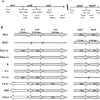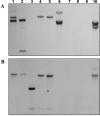Distribution of genes for synthesis of trehalose and Mannosylglycerate in Thermus spp. and direct correlation of these genes with halotolerance
- PMID: 15870334
- PMCID: PMC1087547
- DOI: 10.1128/AEM.71.5.2460-2466.2005
Distribution of genes for synthesis of trehalose and Mannosylglycerate in Thermus spp. and direct correlation of these genes with halotolerance
Abstract
In this study we correlate the presence of genes leading to the synthesis of trehalose and mannosylglycerate (MG) in 17 strains of the genus Thermus with the ability of the strains to grow and accumulate these compatible solutes in a defined medium containing NaCl. The two sets of genes, namely, otsA/otsB for the synthesis of trehalose and mpgS/mpgP for the synthesis of MG, were necessary for the growth of Thermus thermophilus in a defined medium containing up to 6% NaCl. Strains lacking a complete otsA gene did not grow in defined medium containing >2% NaCl. One strain of T. thermophilus lacking the genes for the synthesis of MG did not grow in a medium with >1% NaCl. We did not identify any of these genes in the type strains of the other seven species of Thermus, and none of those strains grew in defined medium with 1% NaCl. The results strongly indicate that the combined accumulation of trehalose and MG is required for optimal osmotic adjustment.
Figures






Similar articles
-
Mannosylglycerate is essential for osmotic adjustment in Thermus thermophilus strains HB27 and RQ-1.Extremophiles. 2007 Nov;11(6):833-40. doi: 10.1007/s00792-007-0106-x. Epub 2007 Aug 29. Extremophiles. 2007. PMID: 17726574
-
Osmotic adaptation of Thermus thermophilus RQ-1: lesson from a mutant deficient in synthesis of trehalose.J Bacteriol. 2003 Oct;185(20):5943-52. doi: 10.1128/JB.185.20.5943-5952.2003. J Bacteriol. 2003. PMID: 14526004 Free PMC article.
-
Diversity and biosynthesis of compatible solutes in hyper/thermophiles.Int Microbiol. 2006 Sep;9(3):199-206. Int Microbiol. 2006. PMID: 17061210 Review.
-
The bacterium Thermus thermophilus, like hyperthermophilic archaea, uses a two-step pathway for the synthesis of mannosylglycerate.Appl Environ Microbiol. 2003 Jun;69(6):3272-9. doi: 10.1128/AEM.69.6.3272-3279.2003. Appl Environ Microbiol. 2003. PMID: 12788726 Free PMC article.
-
Diversity, biological roles and biosynthetic pathways for sugar-glycerate containing compatible solutes in bacteria and archaea.Environ Microbiol. 2011 Aug;13(8):2056-77. doi: 10.1111/j.1462-2920.2010.02390.x. Epub 2010 Dec 22. Environ Microbiol. 2011. PMID: 21176052 Review.
Cited by
-
Characterization of the biosynthetic pathway of glucosylglycerate in the archaeon Methanococcoides burtonii.J Bacteriol. 2006 Feb;188(3):1022-30. doi: 10.1128/JB.188.3.1022-1030.2006. J Bacteriol. 2006. PMID: 16428406 Free PMC article.
-
Glucosylglycerate biosynthesis in the deepest lineage of the Bacteria: characterization of the thermophilic proteins GpgS and GpgP from Persephonella marina.J Bacteriol. 2007 Mar;189(5):1648-54. doi: 10.1128/JB.00841-06. Epub 2006 Dec 22. J Bacteriol. 2007. PMID: 17189358 Free PMC article.
-
Crystallization and preliminary X-ray analysis of mannosyl-3-phosphoglycerate phosphatase from Thermus thermophilus HB27.Acta Crystallogr Sect F Struct Biol Cryst Commun. 2011 Mar 1;67(Pt 3):390-6. doi: 10.1107/S1744309111002843. Epub 2011 Feb 25. Acta Crystallogr Sect F Struct Biol Cryst Commun. 2011. PMID: 21393850 Free PMC article.
-
De novo transcriptome analysis of halotolerant bacterium Staphylococcus sp. strain P-TSB-70 isolated from East coast of India: In search of salt stress tolerant genes.PLoS One. 2020 Feb 10;15(2):e0228199. doi: 10.1371/journal.pone.0228199. eCollection 2020. PLoS One. 2020. PMID: 32040520 Free PMC article.
-
Mannosylglycerate is essential for osmotic adjustment in Thermus thermophilus strains HB27 and RQ-1.Extremophiles. 2007 Nov;11(6):833-40. doi: 10.1007/s00792-007-0106-x. Epub 2007 Aug 29. Extremophiles. 2007. PMID: 17726574
References
-
- Borges, N., J. D. Marugg, N. Empadinhas, M. S. da Costa, and H. Santos. 2004. Specialized roles of the two pathways for the synthesis of mannosylglycerate in osmoadaptation and thermoadaptation of Rhodothermus marinus. J. Biol. Chem. 279:9892-9898. - PubMed
-
- Bouveng, H., B. Lindberg, and B. Wickberg. 1955. Low-molecular carbohydrates in algae. Structure of the glyceric acid mannoside from red algae. Acta Chem. Scand. 9:807-809.
-
- Bradford, M. M. 1976. A rapid and sensitive method for the quantification of microgram quantities of protein utilizing the principle of protein-dye binding. Anal. Biochem. 72:248-254. - PubMed
-
- Cashion, P., M. A. Holder-Franklin, J. McCully, and M. Franklin. 1977. A rapid method for the base ratio determination of bacterial DNA. Anal. Biochem. 81:461-466. - PubMed
Publication types
MeSH terms
Substances
Associated data
- Actions
- Actions
LinkOut - more resources
Full Text Sources
Molecular Biology Databases
Miscellaneous

